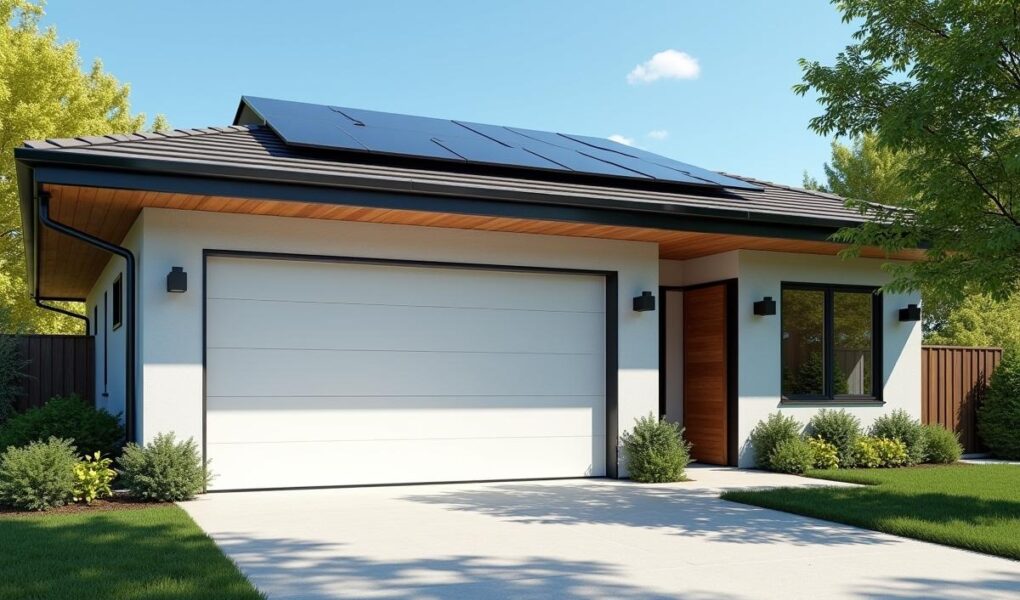An upgrade to your garage door may significantly benefit the environment and save energy. Many homeowners overlook the garage, even though it’s often one of the biggest energy drains. Yet, by simply upgrading to a more efficient model, you can experience not only a more comfortable home but also a positive impact on the environment.
Good insulation, thoughtful design, and modern technology all contribute to a better-performing garage door. While it may seem like a minor update, this change can have major benefits. From limiting heat transfer to cutting back on heating and cooling costs, each step helps create a less wasteful household.
How Eco-friendly Garage Doors Contribute to a Healthier Planet
Eco-friendly garage doors are more than a passing trend. They combine durable, environmentally friendly materials with efficient engineering to reduce heat loss and promote energy conservation. When you choose eco-friendly garage door solutions, you’re not only investing in products made from sustainable resources but also committing to a smarter way of living.
Insulated garage doors can maintain comfortable garage temperatures, which helps keep the rest of your home at a steady climate. This principle of thermal efficiency garage door design prevents the sweltering heat of summer and the biting chill of winter from seeping into your living space. By limiting this unregulated air, you can cut back on heating and cooling, which reduces your reliance on nonrenewable resources.
The ripple effect of an insulated garage door
Investing in an insulated garage door boosts your home’s overall efficiency. Thick insulation layers often come with a high R-value, meaning they impede heat transfer more effectively. With garage door insulation in place, the living areas above or adjacent to the garage stay more comfortable.
As a result, you spend less on climate control, which translates into real savings. By easing pressure on your furnace or air conditioner, you also help lessen carbon emissions. This faster payback on your investment supports a healthier planet in the long run.
The Role of Sealing and Insulation in Garage Door Energy Efficiency
Sealing garage doors may not sound like an exciting task, but it’s crucial if you want to maintain garage door energy efficiency. Air leaks often occur around the edges and bottom of the door, allowing warm or cold air to escape. Adding or replacing weatherstripping can make a significant difference by preventing energy loss.
When combined with quality insulated garage doors, proper sealing can result in a nearly airtight enclosure. This creates a climatecontrolled garage that supports better energy saving garage doors. It also helps protect your car and belongings from extreme temperatures, which can extend their lifespan and reduce waste in the long run.
Weatherstripping for enhanced performance
Even the highest-rated door can lose effectiveness without proper garage door weatherstripping. This simple step blocks drafts, moisture, and debris, helping you guard against mold issues and potential damage. You can find various weatherstripping materials designed specifically for garage doors, each offering a slight variation in durability or cost.
Applied correctly, weatherstripping forms a tight seal along the door’s perimeter. This small measure can lead to a big reduction in heating and cooling bills. It’s a practical, low-cost energy conservation garage upgrade that complements a top-quality door, paving the way for more sustainable garage solutions.
Improving Thermal Efficiency with Smart Garage Door Technology
The evolution of garage door technology goes beyond just insulation and materials. Smart garage door openers can optimize daily use and let you monitor energy flows in real time. By integrating these features, you can manage your home’s resources better and enjoy reduced energy costs throughout the year.
Some smart systems allow you to schedule door openings and closings, limit unnecessary air exchange, and detect temperature shifts in the garage. This level of control helps maintain a cost-effective garage door setup. It can also alert you to potential maintenance issues before they turn into expensive repairs.
Pairing connectivity with efficiency
Connecting your garage door to a home automation system gives you instant oversight of your garage’s condition. If your garage door accidentally remains open, a notification can remind you to close it, keeping temperature levels more stable. Throttling the times when the door is open, especially in extreme weather, improves low-temperature performance in winter and heat retention garage door benefits in summer.
This added control ensures you avoid unnecessary drafts that compromise insulation and force your HVAC system to work harder. Overall, this synergy between energy conservation and real-time data fosters an environment where your door’s performance consistently meets your home’s demands.
Selecting Cost-effective Garage Door Solutions for Better Performance
When you’re ready to make a change, you’ll find plenty of cost-effective garage door solutions on the market. Prioritize options with an impressive R-value, high-grade insulation, and tight sealing. It’s also wise to explore doors made from environmentally friendly materials, which can lower the product’s overall environmental impact.
Many energy-rated garage doors now include features such as multiple layers of insulation and specialized coatings that reflect heat. Pairing these features with strong materials yields a door that can weather harsh climates, ensuring garage door energy performance over many years. Seek out warranties that cover both materials and craftsmanship, as this shows manufacturers stand behind their energy-saving garage solutions.
The significance of material choice
Well-chosen garage door materials resist warping, corrosion, and wear, ensuring longevity and practicality. Steel remains a popular option, often combined with insulating foam for enhanced thermal efficiency. Composite doors use recycled components, adding another sustainable edge to sustainable garage doors.
Whichever material you select, always verify the door’s R-value and its ability to reduce heat transfer. Choosing an advanced garage door materials package that includes resilient finishes can keep your door in top shape longer, diminishing the need for frequent replacement. Over time, these strategic choices contribute to meaningful energy conservation and fewer resources spent on upkeep.
Designing a Climate-controlled Garage for Greater Efficiency
Temperature swings in the garage can place strain on any connected living space. Ensuring a climate control garage helps stabilize internal temperatures, protecting your HVAC system from excessive workloads. This stability leads to garage door energy savings, as your home’s heating and cooling efforts become more focused.
You might consider adding a ventilation system or dehumidifier if you live in a region with high humidity. This supports your sustainable garage doors by preventing rust, mildew, or mold growth. A balanced level of moisture control also ensures your stored items remain in better condition, further reducing waste.
Maintenance for continued performance
Though your garage door is built to last, regular checkups keep it at peak efficiency. Look for wear and tear on the sealing, test your opener’s performance, and examine cables and springs for signs of strain. By conducting routine inspections, you catch small issues before they escalate, resulting in a more cost-effective garage door solutions experience.
Replace worn parts with those made from long-lasting materials, especially if they improve garage door insulation. Upgrading to stronger components can enhance your door’s thermal efficiency, ensuring that your garage remains a tightly regulated space. Eco-friendly decisions in day-to-day upkeep support long-lasting energy conservation benefits.
Combining Versatility and Sustainability for an Energy-efficient Home
Your garage door might seem like a minor piece of the sustainability puzzle, but it plays a major role. Energy-efficient home improvements start with identifying areas where energy wastage occurs, and the garage often tops that list. By sealing gaps, strengthening insulation, and embracing green garage door technology, you move closer to a home that’s both comfortable and eco-conscious.
You can also consider using renewable energy garage door options if your budget allows for solar integration or other innovations. Such choices blend performance with sustainability, illustrating how your garage can become a model for modern living. Meanwhile, improved garage door design ensures the structure remains visually appealing, making your home more attractive for potential buyers down the line.
Beyond the garage: broader environmental benefits
Reducing your home’s overall carbon footprint is about acknowledging the interconnectivity of all its features. An eco-friendly garage door lowers energy consumption not just in the garage but throughout the entire property. The subsequent drop in greenhouse gas emissions benefits the planet at large.
Opting for a high R-value garage door with effective weatherstripping helps your community by reducing regional power demand. When many homes adopt these practices, the strain on local energy infrastructure lessens—a win-win for everyone. By prioritizing garage door efficiency upgrades, you directly support better air quality and a healthier planet.
Building a Smarter Future with Responsible Garage Door Choices
With so many products on the market, it’s crucial to align your garage door purchase with your long-term environmental goals. Modern garage door technology emphasizes durability, performance, and sustainability. Not to mention the bonus of smart garage door openers that keep you connected to your home even when you’re on the go, making it easier to control energy usage with a simple touch on your device.
By combining innovative features like advanced insulation, tight sealing, and real-time system monitoring, you’re creating a space that meets today’s demands and adapts to tomorrow’s challenges. Each detail—from the thickness of the insulation to the composition of the materials—matters in shaping a more responsible and self-sufficient home.
Embracing the future of sustainable garage solutions
Sustainability doesn’t have to be difficult or expensive. Many homeowners discover that small changes, such as upgrading to a high R-value garage door or reinforcing weather seals, generate big returns on comfort and savings. This shift paves the way for energy-saving garage solutions and fosters a culture of responsibility.
If you’re planning any energy-efficient home improvements, the garage door should be on the shortlist. It’s an investment in both your property value and the planet’s well-being. Choosing to embrace a path of efficiency starts with a single, purposeful step—selecting a door that merges technology, design, and sustainable values into one practical package.




